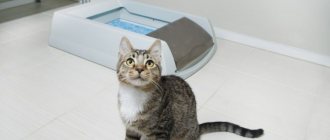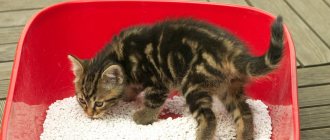8991Administration
A furry friend has appeared at home and you can admire him around the clock without taking your eyes off him. But, do not forget that he is a living creature and wants to eat, and then goes to the toilet. That is, you need to deal with them so that it does not darken the owner’s joy.
But what to do if the kitten does not go to the litter box, while demonstrating its protest to the indicated place every day? The pet does not walk and any owner will get tired of this, because he will need to be cleaned up regularly.
Mother teaches kitten
The first thing you should know: you cannot take a very small kitten from a cat, that is, younger than 1.5 months. Many large nurseries that care about the health and behavior of animals give away kittens after three months.
The fact is that in addition to feeding milk, a mother cat sets an example for her cubs on how to eat, how to hunt and protect themselves. But the most important thing for the owner is that the adult cat shows the cubs where to go to the toilet. This is why it can be difficult to immediately train a one-month-old kitten to the right place.
Bringing the kitten home
When the cub is separated from its mother and begins to live independently, it is taken to a new home.
Before you bring a kitten, you should first prepare everything:
- Buy a tray.
- Select and purchase filler.
- Buy a scoop for cleaning the tray.
- Choose a place for the toilet.
As soon as you bring the kitten into the house, place it in the litter box. To create the smell, you can take a napkin from the house where the kitten used to live, which was lying in the mother’s tray.
Show the kitten his toilet and let him get comfortable. The litter box must be in a secluded place so that the kitten feels comfortable and can do what he needs in silence and without distractions.
The next stage is to let the kitten get comfortable in the space. At the same time, he should not be frightened: nervous animals often have problems with training and adaptation. If the kitten gets scared, it may stop going to the litter box and it will be difficult to force it. The question of why a kitten doesn’t go to the toilet arises quite often, especially in the first months of its life in a new apartment.
In order for him to stop going to a place not intended for these purposes, you will have to make a little effort. In many ways, everything depends on the character of the pet and its intelligence, but occasionally there are cats that mark their territory. Usually this problem arises with the onset of puberty and there are other methods of solving it.
Perhaps the animal will learn on its own, but the owner will still have to help him and let him understand how to do it correctly.
Tray space
Since it is easier to accustom one-month-old kittens to a tray than two-month-old ones, this same tray should appear in your apartment at the same time as the small pet.
But the toilet must be in a certain place and you will have to choose the corner with special care.
By the way, at the same time it is recommended to start making a scratching post, which will help avoid troubles in the form of damaged furniture and wallpaper.
Each representative of the cat family is individual, with its own character and temperament.
And if in most cases it is possible to accustom a street kitten to a litter box quite quickly, since he is used to defiantly relieving himself, then with some people from elite nurseries it is not so simple.
For example, if you purchased a Scottish or British kitten, he may turn out to be very shy.
It will be possible to accustom him to the toilet only if it is located in some secluded place.
And sometimes you even have to purchase a closed toilet.
So, the most suitable place will meet the following conditions:
- silence - away from the refrigerator and other appliances that make noise during operation;
- not on the aisle, preferably in a corner - this could be a place under the bathroom or a corner in any room or corridor;
- The tray should always be freely accessible - not behind a closed door and not in the narrowest corner under the bathroom, where the kitten will not fit.
You need to spend as much time searching for a suitable place as the animal needs.
Otherwise, you may not be able to train your kitten to go to the litter box.
If he finds the angle you have chosen inconvenient, he will continue to shit all over the apartment.
Toilet training process
The little kitten goes to the toilet quite often and can't stand it. The owner will have to learn to determine when he wants to do his business. As soon as the baby begins to squat, he should be calmly transferred to the tray. If suddenly the kitten manages to make a puddle, it should be wiped with a strong odor-repellent agent.
A cat litter box without litter and with one mesh is, of course, convenient for the owner, it is easier to clean and no money is spent on it, however, it can be difficult to immediately accustom a kitten to the litter box for the reason that the cub does not understand what they want from him.
Under natural conditions, animals relieve themselves on the ground or in the sand, and then bury them. You can imitate natural conditions if you use bulk filler. The kitten will be happy to dig into it and this will help make it stop going to the toilet in other places.
Additionally, when the process of accustoming to a place occurs, you can use a special spray. Please note that there are two types of training aids:
- Repellent. They have a strong aroma and mask the smell in the place where the kitten went.
- Attractive. This spray is sprayed directly into the cat's litter box so that habituation in the apartment takes place as quickly as possible.
Usually, training a kitten to use a litter tray is not difficult. Cats are clean animals and get used to going to one place, but for the pet to get used to it quickly, this place must be comfortable.
How to train a small kitten to go to the litter box
1. Show the kitten where the litter box is;
2. Before going to relieve themselves, kittens often begin to fuss, settle in different places, and try to scratch the floor. At such moments, quickly pick up the kitten and put it in the litter box. If the animal runs away, do it again;
3. Suddenly you caught a cat “hot” in the wrong place, take him to the tray, let him continue there;
4. Do not scold or poke the cat's nose into its excrement, this will cause a negative reaction. The animal will be offended and will not understand what they want from it. And next time he will do it to spite you;
5. Be sure to praise the little kitten if he did everything right. You can even give him a treat. This way he will quickly understand that you like his behavior;
6. Wet a piece of paper or cloth into the puddle and place it in the tray. Wash the area where the toilet is not installed with a vinegar solution. Spray with a special aerosol. You can try spreading out dried citrus peels; cats don’t like their smell;
7. Make the cat’s “favorite” places inaccessible. Move the closet, cover the gaps under the sofa with sheets of plywood, plastic bottles or something else;
8. For the first time, limit the cat’s living space to one room or bathroom. If you have a large cage, you can leave the kitten there while you are away. This way he will get used to going to the litter box faster;
9. Take the kitten to the litter box after a large dinner or breakfast. Scratch there. You might get lucky. Never play with your pet in or near the litter box, otherwise your pet will think that the litter box is a playroom.
Be patient, try hard and you will succeed. Don't put off litter box training too long. It will be much more difficult to retrain.
Training errors
If your kitten does not go to the toilet, this may happen for the following reasons:
- The tray is not convenient enough.
- The animal was scared in the place where the tray was installed.
- The kitten was taken too early, and the mother cat did not have time to teach her to go to the litter box on her own.
- The animal has health problems, so it does not have time to reach the place.
If a kitten does not go to the toilet, this problem must be corrected as quickly as possible: the main character traits are formed in childhood, and it will be more difficult to retrain later. The owner must be persistent, but at the same time gentle, so as not to scare the small pet.
Hygiene needs to be paid attention from the very first days of the animal’s appearance in the apartment. The spray is an excellent tool if you need to wean off marks and change your pet's behavior when the kitten does not go to the toilet.
Physiological reasons
This group includes hormonal changes, pathologies and instincts
Only diseases of the urinary system pose a real danger, so it is very important to make sure that they are absent
Sexual heat or hormonal imbalance
During sexual hunting, males actively mark their territory, scaring off competitors and attracting females. This period is easy to track by frequent serenades, unusual aggression and the pungent smell of urine.
Kitties can also mark their territory during heat or pregnancy. In the second case, this instinct is aimed at scaring away potential enemies who could harm unborn kittens.
It is important here to exclude false pregnancy. Despite similar symptoms, such a hormonal imbalance can result in mastitis and other dangerous complications.
Diseases of the urinary system
A cat may urinate in the wrong place due to frequent urges or severe pain. In the first case, she simply does not have time to reach the toilet, and in the second, she tries to find more secluded corners in the hope of getting rid of the unpleasant sensations.
Common diseases of the genitourinary system include:
- Cystitis
. The most common cause of bladder inflammation is bacterial infection. Accompanied by frequent urination, acute pain and a gradual reduction in the amount of urine passed to a couple of drops. - Urolithiasis (UCD)
. It develops when the ureter is blocked by large stones. A sick cat urinates blood, as the sharp edges of the stones injure the mucous membranes. - Urethritis
. It occurs as a complication of cystitis or urolithiasis and affects the urethra. The main signs of this disease are the presence of purulent impurities in the urine and an ammonia or acetone odor of the skin. - Atony of the bladder
. Characteristic of older animals experiencing degenerative changes in organs and tissues. Their muscles lose their strength and elasticity, so the bladder ceases to cope with its main function - holding urine. It begins to leak, and the pet simply does not have time to get to the toilet in time.
If you notice alarming symptoms, be sure to contact your veterinarian. Timely treatment will help avoid complications and speed up the recovery process.
Defending territory
When a new pet appears, the instinct of possessiveness often awakens in the “old-timers”. By marking corners, they demonstrate their superiority, wiping the noses of their four-legged competitors.











